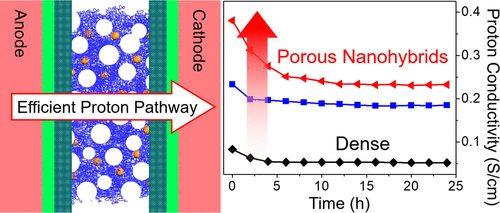当前位置:
X-MOL 学术
›
ACS Sustain. Chem. Eng.
›
论文详情
Our official English website, www.x-mol.net, welcomes your
feedback! (Note: you will need to create a separate account there.)
Sulfur-Doped Hierarchically Porous Open Cellular Polymer/Acid Complex Electrolyte Membranes for Efficient Water-Free Proton Transport
ACS Sustainable Chemistry & Engineering ( IF 7.1 ) Pub Date : 2020-10-16 , DOI: 10.1021/acssuschemeng.0c04601 Ki-Ho Nam 1 , Kwangwon Seo 1 , Sangrae Lee 1 , Haksoo Han 1
ACS Sustainable Chemistry & Engineering ( IF 7.1 ) Pub Date : 2020-10-16 , DOI: 10.1021/acssuschemeng.0c04601 Ki-Ho Nam 1 , Kwangwon Seo 1 , Sangrae Lee 1 , Haksoo Han 1
Affiliation

|
Fuel cells are cleaner alternatives of sustainable green energy sources. Their proton exchange membranes continue to be a key component; however, there are several challenges associated with their application. To overcome these challenges, we designed and fabricated open cellular anhydrous polybenzimidazole (PBI) electrolyte nanohybrid membranes with high proton conductivity and long-term stability by facile non-solvent-induced phase separation. When the membranes were heated to 300 °C, the Friedel–Crafts reaction between the electron-rich phenyl ring and carboxylic acid groups covalently cross-linked the PBI chains. A hierarchical porous structure was effectively tailored from fingerlike cavities to the sponge pores simply by tuning the S-doped–reduced graphene oxide (S-RGO) concentration. The direct incorporation of S-RGO into the micropore channels of membrane yielded exceptional phosphoric acid (H3PO4) doping level of 1158.1% and high proton conductivity of 0.23 S cm–1 at 160 °C and 0% humidity, thereby showing a synergistic effect by proton transfer bridge, continuous proton transport channels, and H3PO4 reservoirs. Furthermore, the current density at 0.6 V and maximum power density of the S-RGO-reinforced PBI (S-PBI) nanohybrid membranes were increased to 716 mA cm–2 and 850 mW cm–2, respectively. The interconnected spongelike porous S-PBI nanohybrid membranes with significantly reduced mass transfer resistances exhibited excellent performance in high-temperature water-free hydrogen fuel cells.
中文翻译:

硫掺杂分层多孔多孔聚合物/酸复合电解质膜,用于高效无水质子运输
燃料电池是可持续绿色能源的更清洁替代品。它们的质子交换膜仍然是关键组成部分。然而,与它们的应用相关的一些挑战。为了克服这些挑战,我们设计和制造了通过简便的非溶剂诱导的相分离而具有高质子传导性和长期稳定性的开孔无水聚苯并咪唑(PBI)电解质纳米杂化膜。当膜加热到300°C时,富电子苯环和羧酸基团之间的Friedel-Crafts反应共价交联了PBI链。只需调整S掺杂还原的氧化石墨烯(S-RGO)的浓度,就可以有效地将分层的多孔结构从指状腔改制成海绵孔。3 PO 4)的掺杂水平为1158.1%,在160°C和0%湿度下的质子电导率为0.23 S cm –1,从而显示出质子传递桥,连续的质子传输通道和H 3 PO 4储层的协同作用。此外,S-RGO增强的PBI(S-PBI)纳米杂化膜在0.6 V时的电流密度和最大功率密度分别增加到716 mA cm -2和850 mW cm -2。具有显着降低的传质阻力的相互连接的海绵状多孔S-PBI纳米杂化膜在高温无水氢燃料电池中表现出出色的性能。
更新日期:2020-11-02
中文翻译:

硫掺杂分层多孔多孔聚合物/酸复合电解质膜,用于高效无水质子运输
燃料电池是可持续绿色能源的更清洁替代品。它们的质子交换膜仍然是关键组成部分。然而,与它们的应用相关的一些挑战。为了克服这些挑战,我们设计和制造了通过简便的非溶剂诱导的相分离而具有高质子传导性和长期稳定性的开孔无水聚苯并咪唑(PBI)电解质纳米杂化膜。当膜加热到300°C时,富电子苯环和羧酸基团之间的Friedel-Crafts反应共价交联了PBI链。只需调整S掺杂还原的氧化石墨烯(S-RGO)的浓度,就可以有效地将分层的多孔结构从指状腔改制成海绵孔。3 PO 4)的掺杂水平为1158.1%,在160°C和0%湿度下的质子电导率为0.23 S cm –1,从而显示出质子传递桥,连续的质子传输通道和H 3 PO 4储层的协同作用。此外,S-RGO增强的PBI(S-PBI)纳米杂化膜在0.6 V时的电流密度和最大功率密度分别增加到716 mA cm -2和850 mW cm -2。具有显着降低的传质阻力的相互连接的海绵状多孔S-PBI纳米杂化膜在高温无水氢燃料电池中表现出出色的性能。










































 京公网安备 11010802027423号
京公网安备 11010802027423号